Location
2020/10/30 11:51:27 37.92 26.79 21
Moment Tensor Comparison
The following compares this source inversion to the USGS Rapid Moment Tensor Solution and to the Harvard CMT solutions, if they are available.
| SLU |
SLU RMT |
USGS |
USGS |
Moment Tensor Solution
ENS 2020/10/30 11:51:27:0 37.92 26.79 5.0 7.0 Greece
Best Fitting Double Couple
Mo = 3.35e+26 dyne-cm
Mw = 6.95
Z = 5 km
Plane Strike Dip Rake
NP1 78 73 -100
NP2 290 20 -60
Principal Axes:
Axis Value Plunge Azimuth
T 3.35e+26 27 177
N 0.00e+00 10 82
P -3.35e+26 61 333
Moment Tensor: (dyne-cm)
Component Value
Mxx 2.01e+26
Mxy 1.60e+25
Mxz -2.63e+26
Myy -1.50e+25
Myz 7.19e+25
Mzz -1.86e+26
##############
######################
#####---------------########
##-----------------------#####
##---------------------------#####
#-------------------------------####
-------------- ------------------###
--------------- P -------------------###
--------------- --------------------##
------------------------------------------
-------------------------------------###--
---------------------------------########-
----------------------------#############-
#------------------#####################
########################################
######################################
####################################
##################################
############## #############
############# T ############
########## #########
##############
Global CMT Convention Moment Tensor:
R T P
-1.86e+26 -2.63e+26 -7.19e+25
-2.63e+26 2.01e+26 -1.60e+25
-7.19e+25 -1.60e+25 -1.50e+25
|
SLU RMT
SLU
USGS/SLU Moment Tensor Solution
ENS 2020/10/30 11:51:27:0 37.92 26.79 21.0 7.0 Greece
Stations used:
GE.CSS HL.ATH HL.EVR HL.GVD HL.IACM HL.ITM HL.KARP HL.KLV
HL.KSL HL.KTHA HL.KZN HL.NEO HL.NVR HL.SIVA HL.SKY HL.SMTH
HL.TETR HL.VAM HL.VLY HT.AGG HT.ALN HT.AOS2 HT.EVGI HT.GRG
HT.KAVA HT.KNT HT.KPRO HT.NEST HT.OUR HT.PAIG HT.RTZL
HT.SOH HT.SRS HT.THAS HT.THE HT.TYRN HT.XOR KO.AFSR KO.ARMT
KO.BALB KO.BGKT KO.CTYL KO.EDC KO.GEML KO.HDMB KO.ISK
KO.KAMT KO.KAVV KO.KCTX KO.KIZT KO.KONT KO.KULU KO.KURC
KO.LADK KO.LFK KO.LOD KO.RKY KO.RUZG KO.SAUV KO.SDAG
KO.SHUT KO.SILT KO.SVRH KO.YALI KO.YLV MN.ISP MN.KEK MN.THL
Filtering commands used:
cut o DIST/3.3 -80 o DIST/3.3 +150
rtr
taper w 0.1
hp c 0.01 n 3
lp c 0.02 n 3
Best Fitting Double Couple
Mo = 2.37e+26 dyne-cm
Mw = 6.85
Z = 8 km
Plane Strike Dip Rake
NP1 268 45 -95
NP2 95 45 -85
Principal Axes:
Axis Value Plunge Azimuth
T 2.37e+26 0 1
N 0.00e+00 4 271
P -2.37e+26 86 93
Moment Tensor: (dyne-cm)
Component Value
Mxx 2.37e+26
Mxy 6.12e+24
Mxz 1.27e+24
Myy -7.43e+23
Myz -1.46e+25
Mzz -2.36e+26
###### T #####
########## #########
############################
##############################
##################################
###########---------------##########
#######-------------------------######
#####-------------------------------####
###-----------------------------------##
##--------------------------------------##
----------------------- ----------------
##--------------------- P ----------------
###-------------------- ---------------#
####-----------------------------------#
######------------------------------####
########-------------------------#####
############---------------#########
##################################
##############################
############################
######################
##############
Global CMT Convention Moment Tensor:
R T P
-2.36e+26 1.27e+24 1.46e+25
1.27e+24 2.37e+26 -6.12e+24
1.46e+25 -6.12e+24 -7.43e+23
Details of the solution is found at
http://www.eas.slu.edu/eqc/eqc_mt/MECH.NA/20201030115127/index.html
|
Body-wave Moment Tensor (Mwb)
Moment 2.546e+19 N-m
Magnitude 6.87 Mwb
Depth 8.0 km
Percent DC 80%
Half Duration -
Catalog US
Data Source US 4
Contributor US 4
Nodal Planes
Plane Strike Dip Rake
NP1 268 34 -103
NP2 104 57 -81
Principal Axes
Axis Value Plunge Azimuth
T 2.670e+19 N-m 11 188
N -0.269e+19 N-m 7 279
P -2.401e+19 N-m 76 42
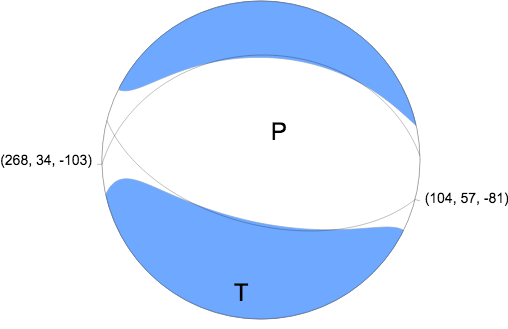
|
W-phase Moment Tensor (Mww)
Moment 4.087e+19 N-m
Magnitude 7.01 Mww
Depth 11.5 km
Percent DC 85%
Half Duration 8.39 s
Catalog US
Data Source US 4
Contributor US 4
Nodal Planes
Plane Strike Dip Rake
NP1 93 61 -91
NP2 276 29 -88
Principal Axes
Axis Value Plunge Azimuth
T 4.241e+19 N-m 16 184
N -0.328e+19 N-m 1 94
P -3.913e+19 N-m 74 0
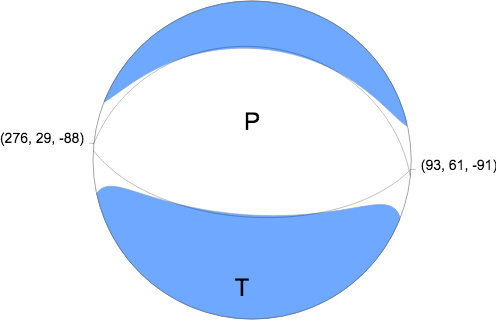
|
USGS finite fault inversion
The USGS final fault solution is given at
https://earthquake.usgs.gov/earthquakes/eventpage/us7000c7y0/finite-fault?source=us&code=us7000c7y0_1. This solution pefers the EW striking nodal plane but assumes a source depth of 21 km.
Data set
The following broadband stations passed the QC and were used for the source inversion.
AAK
ABPO
ALE
ASCN
BBSR
BILL
BORG
BORK
CHTO
CMLA
COLA
DGAR
EDA
FDFM
FFC
FOMA
FURI
HRV
INCN
IVI
KBL
KEV
KURK
LVZ
MA2
MACI
MAKZ
MBAR
MPG
MSEY
NIL
PALK
PET
RCBR
RER
ROCAM
SACV
SFJD
SHEL
SOK
SSPA
SUR
TATO
TIXI
TLY
TSUM
ULN
WUS
YAK
YSS
Grid Search
All observed and Greens function waveforms are corrected to instrument response to ground velocity in meters/sec for the passband of 0.004 - 5 Hz. The traces were then lowpass filtered at 0.25 Hz and interpolated to a sample rate of 1 second.
For the grid search, the observed traces and Green's functions are read in an cut using the following commands
Processing parameters
#####
# Driver script for the teleseismic waveform inversion
#
# The depth HS must be of the form 0010 for a depth of 1.0 km
# of 6700 for a depth of 670.0 km
#
# The Filter_Band is an integer with the following meansing
#
# FILTER_BAND 1/FH 1/FL
# 1 60 12 for Mw < 6.4
# 2 100 20 6.4 =< Mw < 6.8
# 3 120 40 6.8 =< Mw < 7.2
# 4 143 80 7.2 =< Mw < 9.3
#####
# Source duration - halfwidth of triangular function
# this filters only the Green functions
#
# halfwidth = 1.05 * 10-8 * M0^1/3 (M0 is dyne-cm)
#
# MW half-width (sec)
# 5.0 0.75
# 6.0 2.45
# 7.0 7.7
# 8.0 24.5
# 9.0 74.3
# 0.5*(MW - 9)
# or half-width=74.3*10
# or echo 6.93 | awk '{print 74.3*exp(0.5*log(10.0)*(0050 - 9.0)) }'
#####
# Processing window for P (use SAC variable A for P arrival
# Start A - 30
# End A + 2*HALFWIDTH + 0.03*HS + 30 + 1/FH +100
# Processing window for SH (use SAC variable T0 for SH arrival
# Start T0 - 60
# End T0 + 2*HALFWIDTH + 0.06*HS + 30 + 1/FH +170
# Processing window for SV (use SAC variable T1 for SV arrival
# Start T1 - 60
# End T1 + 2*HALFWIDTH + 0.06*HS + 30 + 1/FH +170
#
# The term involving HS serves to include the depth phases and
# to exclude the PP or SS at most distanace
#####
The cut windows attempt to include the P, pP, sP, pS, S and sS arrivals. However, oen must be very careful about the fact that PP may be included in some distance ranges.
The waveforms are then
bandpass filtered by the application of the following high- and low-pass stages (an optional microseism filter):
hp c 0.0083 2
lp c 0.0250 2
int
br c 0.12 0.25 n 4 p 2
The traces were next integrated to ground displacment in meters.
Finally the observed data are interpolated to ahve the same sampling at the Green's functions.
NOTE: this was done for speed. The proper sequence is to read traces, filter and then cut - gsac will be modified to introduce a command CUTWR to define the cut upon a write.
The source inversion is a multipass operation since a lower frequency filter band is used for larger earthquakes and since a search is made over depth. Up to three passed of the outer loop are made, after which the moment magnitude is determined and filter settings readjusted. The inner loop over depth samples all depths from 0 to 800 km with 5 km increments in depth to 50 km, followed by 10 km depth sampling for the remaining range.
The following filter ranges are used according to the moment magnitude Mw:
FILTER_BAND 1/FH(s) 1/FL(s)
1 60 12 Mw < 6.4
2 100 20 6.4 < Mw <= 6.9
3 120 40 Mw > 6.9
The map displays the distribution of stations used for this source inversion.
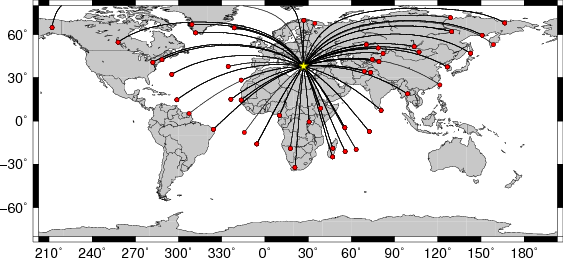
Location of the earthquake (yellow star) and great circle path from the epicenter to each station (red) [created using GMT (Wessel, P., and W. H. F. Smith, New version of Generic Mapping Tools released, EOS Trans. AGU, 76 329, 1995.)]
|
For this data set the favored solution is
WVFGRD96 5.0 290 20 -60 6.95 0.5032
The following figures show the sensitivity of the goodness of fit parameter so
source depth, the waveform comparison as a function of epicentral distance in degrees and the source to station azimuth
Depth Sensitivity
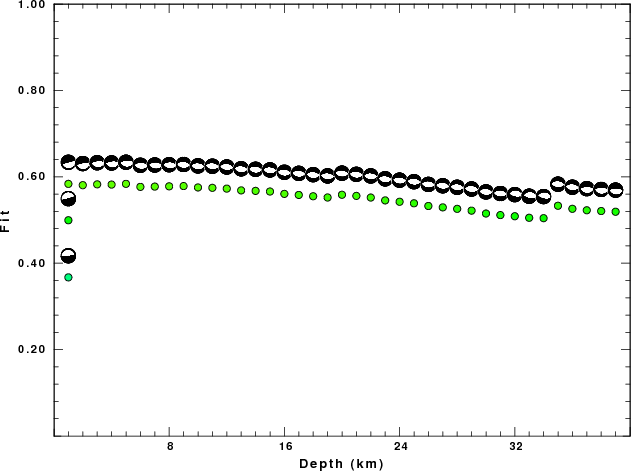
|
|
Goodness of fit as a function of source depth. The measure is 1 - SUM (o -p)2 / SUM o2. A value of 1.0 is the best fit. The best double couple mechanism for the solution depth is plotted above goodness of fit value to indicate how the mefhanism may change with depth.
|
Detailed Waveform Comparison
| P-wave Z component |
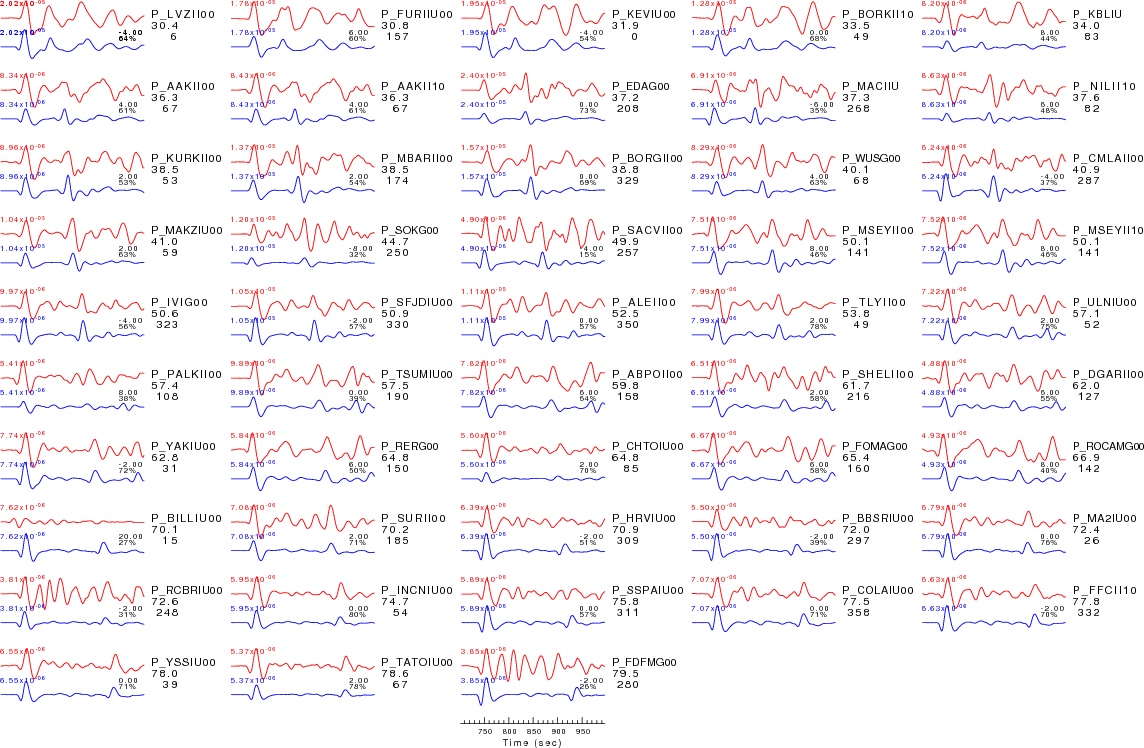
|
|
Comparison of the observed traces (red) and solution predicted traces (blue) ordered in terms of increasing epicentral distance. Each pair of traces is annotated with the station name, epicentral distance in degrees, source to station azimuth in degrees. Each pair of traces is plotted with the same scale and the peak amplitudes are indicated at the lect of each trace. Finally the time shift between the P-wave first arrival picked and the the theoretical P-wave first arrival in the predicted trace is indicated, with a positive sign indicating that the predicted trace has been shifted to the right by the given number of seconds.
as a function of source to station azimuth in degrees (D). The purpose of this display is to highlight the azimuthal dependence on the first motion. The traces are annotated with the station name at the top.
|
| SH-wave T component |
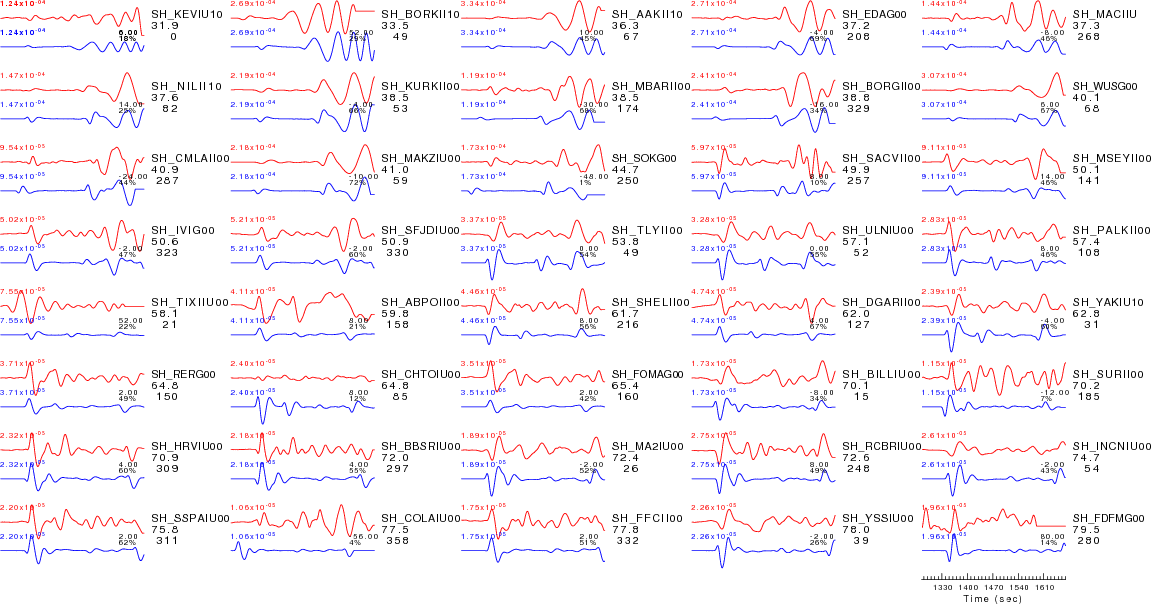
|
|
Comparison of the observed traces (red) and solution predicted traces (blue) ordered in terms of increasing epicentral distance. Each pair of traces is annotated with the station name, epicentral distance in degrees, source to station azimuth in degrees. Each pair of traces is plotted with the same scale and the peak amplitudes are indicated at the lect of each trace. Finally the time shift between the P-wave first arrival picked and the the theoretical P-wave first arrival in the predicted trace is indicated, with a positive sign indicating that the predicted trace has been shifted to the right by the given number of seconds.
as a function of source to station azimuth in degrees (D). The purpose of this display is to highlight the azimuthal dependence on the first motion. The traces are annotated with the station name at the top.
|
| SV-wave R component |
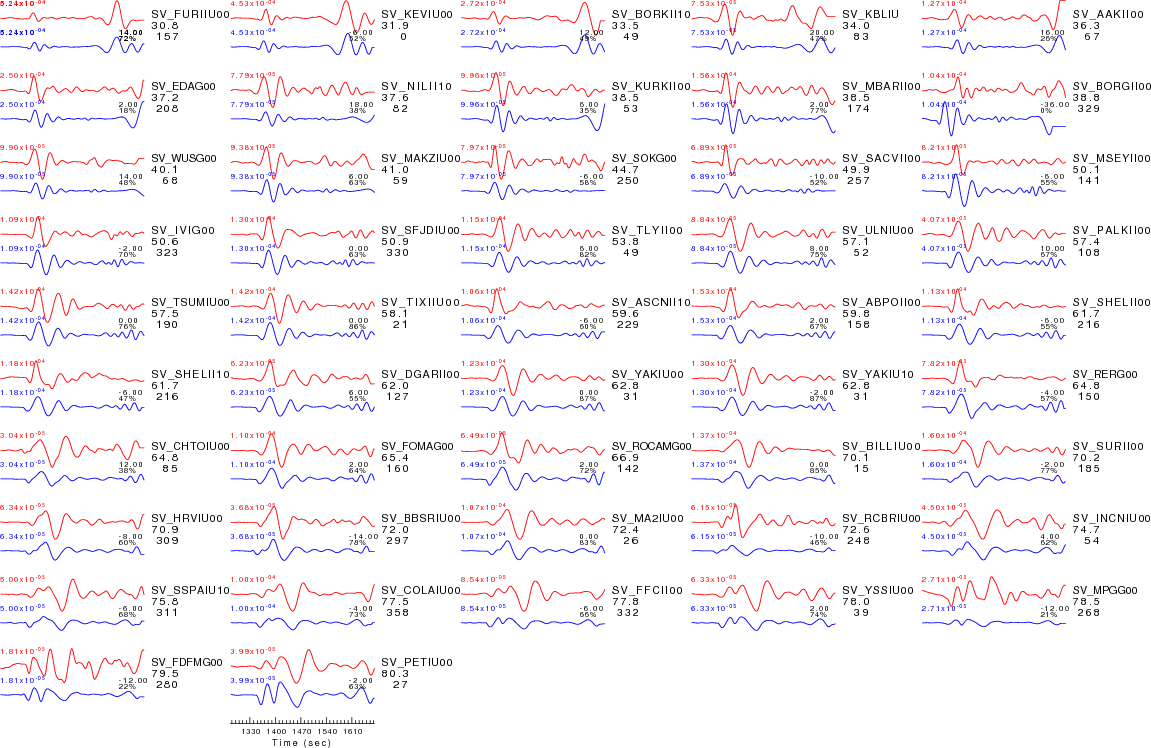
|
|
Comparison of the observed traces (red) and solution predicted traces (blue) ordered in terms of increasing epicentral distance. Each pair of traces is annotated with the station name, epicentral distance in degrees, source to station azimuth in degrees. Each pair of traces is plotted with the same scale and the peak amplitudes are indicated at the lect of each trace. Finally the time shift between the P-wave first arrival picked and the the theoretical P-wave first arrival in the predicted trace is indicated, with a positive sign indicating that the predicted trace has been shifted to the right by the given number of seconds.
as a function of source to station azimuth in degrees (D). The purpose of this display is to highlight the azimuthal dependence on the first motion. The traces are annotated with the station name at the top.
|
Inversion Details
Output of wvfgrd96 for the best depth..
Processing times
Starting Grid Search : Tue Dec 15 17:45:09 UTC 2020
Starting documentation : Tue Dec 15 17:56:44 UTC 2020
Processing Completed : Tue Dec 15 17:56:44 UTC 2020
Last Changed Tue Dec 15 19:15:47 UTC 2020






